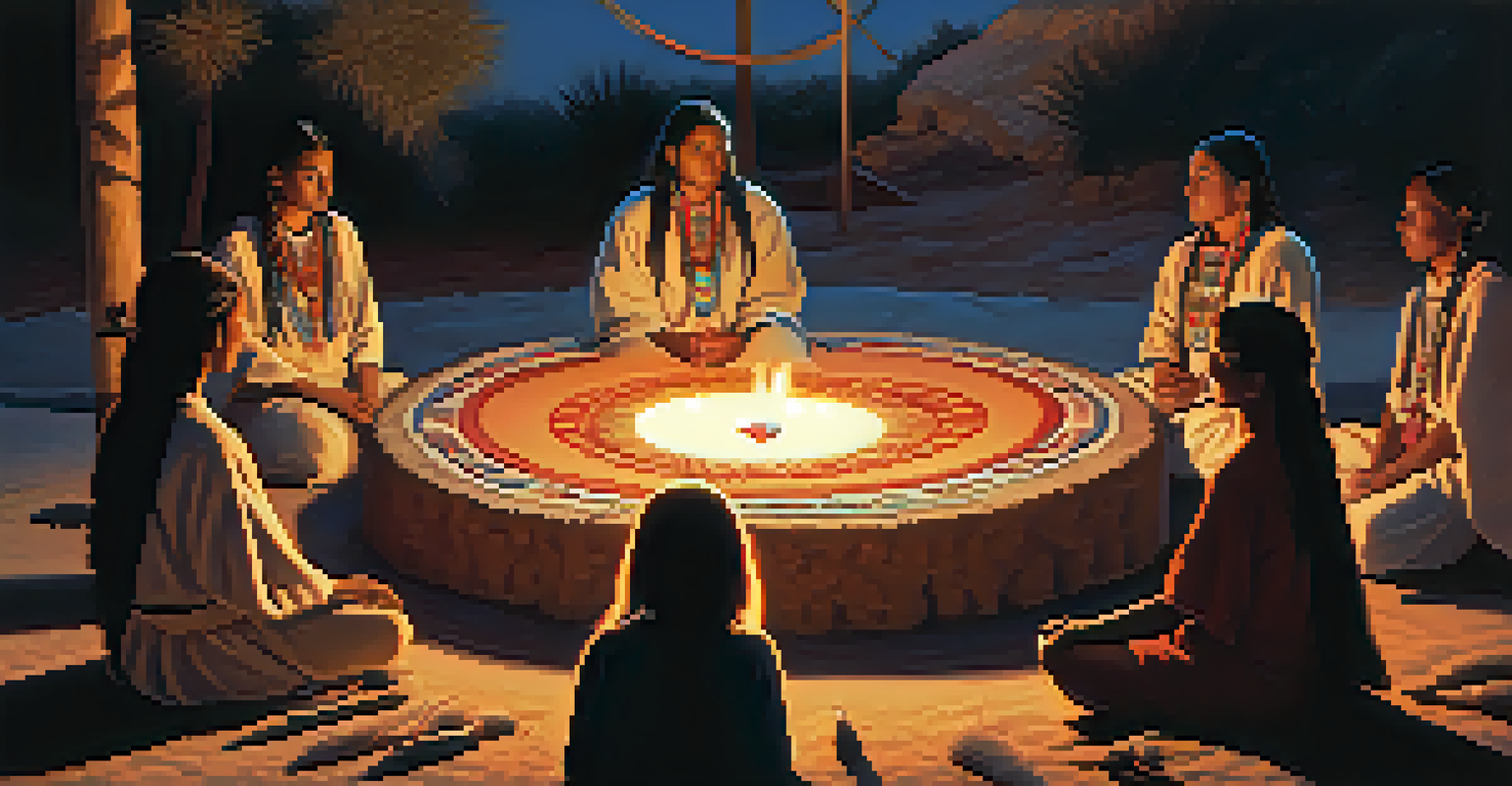Exploring the Spiritual Aspects of Peyote and Oneness

Understanding Peyote: A Sacred Plant
Peyote is a small, spineless cactus native to Mexico and the southwestern United States, known for its psychoactive properties. For centuries, it has been utilized in various indigenous cultures for spiritual and medicinal purposes. The active compound, mescaline, induces altered states of consciousness, which many believe facilitate deeper connections with the universe.
The journey inward is often the most profound, as it allows us to connect with the universe and our true selves.
In many Native American traditions, peyote is considered a sacred plant, revered for its ability to foster healing and self-discovery. It is often used in religious ceremonies, where participants seek guidance, insight, and a sense of unity with the cosmos. This spiritual significance amplifies the plant's role beyond mere recreation, positioning it as a tool for profound personal transformation.
Understanding peyote's place in these cultures helps us appreciate its deeper meanings. Rather than seeing it solely as a substance, it is essential to recognize its historical and spiritual context. This awareness sets the stage for exploring the concept of oneness that peyote often reveals.
The Experience of Oneness in Peyote Ceremonies
When consumed in a ceremonial setting, peyote can lead to experiences of oneness, where individuals feel a deep connection to all living things. This feeling transcends the boundaries of self and ego, allowing participants to see themselves as part of a greater whole. Many describe this experience as life-changing, providing clarity and a sense of peace.

During these ceremonies, participants often engage in prayer, singing, and sharing stories, which enhance the communal aspect of the experience. The shared energy and intention create a safe space for personal revelations and collective healing. It’s in this environment that the magic of oneness truly unfolds, highlighting the interconnectedness of all beings.
Peyote's Spiritual Significance
Peyote is revered in indigenous cultures for its spiritual and healing properties, serving as a tool for personal transformation.
These profound moments can lead to insights about life, purpose, and relationships. The experience of unity fosters empathy and compassion, reminding participants of their responsibility to each other and the earth. Through peyote, one can explore what it means to be part of something much larger than oneself.
Cultural Significance of Peyote and Spiritual Practices
Peyote's use in spiritual practices is deeply embedded in the cultures of various Indigenous groups, particularly within the Native American Church. These practices are not only about the plant itself but also encompass a broader worldview that values nature, community, and spirituality. The rituals surrounding peyote use often emphasize respect for the earth and the interconnectedness of life.
In the end, we are all just walking each other home.
In these cultural contexts, peyote serves as a bridge to the spiritual realm, facilitating communication with ancestors and spiritual guides. Participants often report receiving messages or insights during their experiences, reinforcing the belief that they are not alone on their journey. This connection to the spiritual realm is central to understanding the holistic approach to healing and spirituality in these communities.
The respect and reverence for peyote highlight the importance of maintaining cultural traditions and practices. As society becomes more aware of these practices, it also emphasizes the need for cultural sensitivity and understanding. Acknowledging the cultural significance of peyote can foster greater appreciation for the wisdom embedded in these age-old traditions.
Comparing Peyote to Other Spiritual Practices
While peyote is unique, there are parallels with other spiritual practices that seek to achieve oneness. For example, meditation, yoga, and various forms of shamanic journeys also aim to connect individuals with a larger sense of self and the universe. Each practice, while distinct, shares a common thread of seeking deeper understanding and connection.
In yoga, practitioners often experience a sense of unity through physical postures and breathwork, which can lead to profound moments of stillness and clarity. Similarly, meditation encourages a focus on the present moment, allowing individuals to transcend the noise of daily life and connect with their inner selves. These experiences echo the insights gained through peyote ceremonies.
Experiencing Oneness in Ceremonies
Participants in peyote ceremonies often report profound experiences of oneness, fostering a deep connection to all living things.
By comparing these practices, we can appreciate the diverse pathways available for exploring spirituality. Each method offers unique tools for self-discovery and connection, illustrating that there are many avenues to explore the idea of oneness. Whether through peyote, meditation, or yoga, the journey toward unity is deeply personal yet universally relatable.
Challenges and Misunderstandings Surrounding Peyote
Despite its rich spiritual significance, peyote faces numerous challenges, particularly in modern society. Misunderstandings about its use can lead to stigmatization, often reducing it to a mere recreational substance. This narrow perspective neglects the depth of cultural and spiritual practices associated with peyote, which can obscure its potential for healing and growth.
Moreover, the availability of peyote is also a concern. Overharvesting and habitat loss threaten this sacred plant, making it increasingly difficult for Indigenous communities to access it for traditional use. This situation raises important questions about conservation and the responsibility of society to protect these valuable cultural resources.
Addressing these challenges requires open dialogue and education about the cultural and spiritual significance of peyote. By fostering understanding, we can create a more respectful environment that honors the traditions surrounding this sacred plant. Challenging misconceptions helps pave the way for a broader acceptance of peyote's role in spiritual exploration.
Personal Transformations Through Peyote Experiences
Many individuals who partake in peyote ceremonies report significant personal transformations. These experiences can lead to heightened self-awareness, enabling people to confront their fears, traumas, and life’s challenges with newfound clarity. The insights gained during these journeys often inspire lasting change, prompting individuals to reassess their life choices and relationships.
For instance, someone struggling with grief may find solace and understanding in the oneness experienced during a peyote ceremony. This connection can help them navigate their emotions and foster healing in ways they never thought possible. Such transformative experiences illustrate the profound impact that spirituality can have on personal growth.
Challenges Facing Peyote Practices
Peyote faces challenges such as stigmatization and overharvesting, highlighting the need for cultural sensitivity and conservation.
The stories of transformation through peyote are as diverse as the individuals who partake in these ceremonies. Each journey is unique, yet they all share a common thread: a desire for connection and understanding. These narratives serve as powerful reminders of the potential for change and healing within us all.
Integrating Spiritual Insights into Daily Life
One of the most significant aspects of spiritual experiences, including those induced by peyote, is the challenge of integrating insights into daily life. After such profound revelations, individuals often seek ways to embody their newfound understanding in their everyday existence. This process can be both rewarding and daunting, as it requires a commitment to change.
Practices such as journaling, meditation, or even sharing experiences with others can help facilitate this integration. By reflecting on insights gained during peyote ceremonies, individuals can cultivate a deeper sense of purpose and connection in their lives. These practices not only reinforce the lessons learned but also create a supportive community for ongoing growth.

Ultimately, the journey does not end with the ceremony; it continues as individuals strive to live in accordance with their spiritual insights. This ongoing process of integration highlights the importance of mindfulness and intentionality in daily life. By embracing these practices, one can weave the wisdom of oneness into the fabric of their existence.